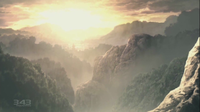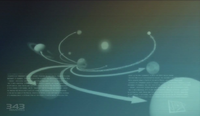Heian: Difference between revisions
From Halopedia, the Halo wiki
mNo edit summary |
mNo edit summary |
||
| Line 1: | Line 1: | ||
{{Era|LE}} | {{Era|HE|LE}} | ||
{{Ratings}} | {{Ratings}} | ||
Revision as of 16:24, December 29, 2009
Heian was a world in the Milky Way Galaxy. The planet was terrestrial, with a breathable atmosphere and an Earth-like surface. Meteor showers were common on this world, as thousands of meteors orbited the planet.[1]
History
At some point predating both Humanity and the Covenant, the planet was inhabited by a yet-unknown civilization. They likely vanished at some point, as their cities were abandoned, yet mostly intact, by the 26th century.
During the Human-Covenant War, the world was the site of an important Covenant logistics base, from which supplies were delivered to the rest of the planets in the system, as well as the entire sector. The UNSC deployed a team of ODSTs and a Spartan on the planet, with the mission to assassinate the Prophet in charge of the operations within the system, in order to stop the Covenant supply chain. They were also tasked with gathering intelligence on the unknown ruins. The team succeeded in their mission, but the Spartan was lost in combat against a Hammer-wielding Brute and an ODST, Checkman, was killed after striking an asteroid in orbit and burned up in the atmosphere after losing control of his SOEIV.[1]
Ruins
The architecture of the unknown ruins on the planet structures greatly resembles ancient Japanese architecture on Earth, complete with decorations containing dragon-like creatures and statuaries distinctively similar to statues of Buddha. Most of the buildings have pagoda-like roof structures. Overall, the designs are very ornate and full of carvings. Curiously, the overall scale of most structures is massive; one step in a staircase may be the height of an average human. Some structures seem like a mix of ancient Japanese and relatively modern industrial architecture, including a water processing facility with aqueducts and valve systems nigh-identical to those used by humans.[1]
The Department of Xenoarchaeological Studies at the University of Edinburgh believed that there are potential Forerunner relics somewhere in the colony.[2]



